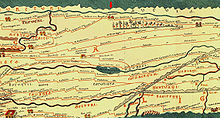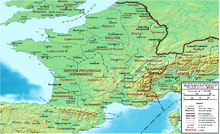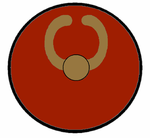Dux mogontiacensis


The Dux Mogontiacensis (literally: "Army leader of the Mainz region") was a high officer in the late antique army of the Western Roman Empire and commander in chief of the border army ( Limitanei ) in the province of Germania great .
The administrative area of the Dux Mogontiacensis included the Rhine border between Seltz and Andernach . The office is only mentioned in the Notitia Dignitatum . He was under the Magister Peditum Praesentalis (commander in chief of the infantry) of the western empire. At the imperial court, the Dux belonged to the highest class of viri spectabiles .
historical overview
Around the year 300 Diocletian (284-305) rearranged the provinces and separated the civil and military administration. Since the middle of the 4th century there have been repeated incursions by the Alemanni , who temporarily occupied areas and garrisons on the left bank of the Rhine. The field army was subordinate to the Comes per utramque Germaniam . Border defense in the province of Germania prima was originally the responsibility of the Dux Germaniae primae . Towards the end of the 4th or beginning of the 5th century, his area of command was divided between the Dux Mogontiacensis , who belonged to the Roman knighthood , and the Comes tractus Argentoratensis , based in Mainz and Strasbourg.
Emperor Valentinian I (364–375) had a comprehensive construction program carried out again from 369 to strengthen the Danube-Iller-Rhein-Limes and strengthen or rebuild the garrison type of the Mainz ducat. The new limit units were apparently removed from the infantry Legiones palatinae ( Guard ) and Comitatenses as well as Auxilia palatina of the Gallic field army and relocated to the Rhine. The individual units had a crew strength of about 400 men. According to another opinion, the Mainz ducat was first established by Stilicho in 396 , on the occasion of a trip to the Rhine or possibly after the Germanic invasion of 406/407 .
In older research, the view was mostly held that the Roman border defense in the area of the Mainz ducat was largely destroyed by the invading Vandals , Alans and Suebi in 406/407 and that the remaining units were incorporated into the mobile field army. In recent research the opinion is partly expressed that the Roman administration, based on Burgundian federates , existed until the middle of the 5th century, possibly until the end of the Western Roman Empire in 476/480.
Administrative staff
The Officium (administrative staff) of the Dux comprised the following offices:
- Princeps ex officiis magistrorum militum praesentalium alternis annis (head of the office, who was appointed annually by the Magister Militum)
- Numerarius a parte peditum semper (treasurer from the army)
- Commentariensis a parte peditum semper (bookkeeper, legal expert from the army)
- Adiutor (helper)
- Subadiuva (subordinate helpers)
- Regerendarius (administration)
- Exceptores (lawyers)
- Singulares et reliqui officiales (Guard and other officials)
troops
In addition to the administrative staff, the Dux had eleven prefects and the limit units they commanded at their disposal (sub-dispositione) . The troop list probably represents the crew level under Constantine III. (407-411) or Constantius III. (the actual regent since 412). There were also other forts , such as Alteium ( Alzey Castle ), in which Foederaten (allies) were stationed, but which were not included in the Notitia Dignitatum as non-Roman or irregular troop units . The origin of the troops - as well as the time of their stationing - is controversial in research.
Distributio Numerorum
According to the ND Occ. the following units were available to the Dux :
| Officers / units / forts | comment | Illustration |
|---|---|---|
| Limitanei | ||
| Praefectus militum Pacensium in Saletium | This unit emerged from the Legio I Flavia Pacis . You may replaced soon after 406/407 the laid Valentinian I. 370 to the Rhine Milites Cornacenses , in turn, from parts of the in Cornacum ( Sotin stationed) cavalry of Equites Dalmatae , under the command of the Dux Pannoniae secundae ripariensis et Saviae were , emerged. Pacensis was a city in the south of Portugal, the Colonia Civitas Pacensis , today's Beja . The soldiers in Saletium could also have come from a department that was once stationed there; maybe one of the Spanish legions. The shield pattern of the Legio I Flavia Pacis probably represents a four-spoke wheel. | |
| Praefectus militum Menapiorum in tabernae | The soldiers of this unit were members of the tribe of Menapii , whose territory was in present-day Belgium , the Civitas Menapiorum ; This administrative unit later became the Civitas Turnencensium . The Milites Menapii presumably emerged from the Comitatensischen Menapii seniores , who were under the command of the Magister equitum Galliarum . A snake-like figure was painted on her shield, probably a simplistic representation of a Draco . | |
| Praefectus militum Anderetianorum in Vicus Iulius | From Constantine III. (407–411) relocated to the Rhine in 408, they replaced the portisienses stationed by Valentinian I in Pfortz . In the Notitia another troop bears this name, this could indicate that both units were previously stationed in the Saxon coastal fort Anderitum (Pevensey). These are the marines under the Praefectus classis Anderetianorum , stationed in Parisius (Paris). | |
| Praefectus militum Vindicum in Nemetum | The parent unit of the Milites Vindices can be seen in the Vindices , an Auxilium palatinum of the Magister Militum Praesentalis II of the Eastern Empire. It could be proven in Speyer until at least 422/423. The name Vindices is purely functional and means "the defenders, protectors" or "avengers". It does not refer to a tribe or a personality. One of the units under the command of the Magister Militum Praesenatlis I are the Defensores , which can also be translated as "the defenders". These have a very similar shield motif. Perhaps another example of a force that was later split between the two magistri . The painted shield of the vindices shows a purple , two-headed zoomorphic motif on an ocher-colored background, which occurs very frequently in the notitia, especially in the units of the auxilia palatina . In two of the surviving manuscripts of the Notitia, a small loop-like motif can be seen on the upper edge of the shield. It could either be a wreath or a staurogram . Small badges or the like were often depicted on the upper edge of late Roman shields. A similar pattern to that used by the Vindices is also reproduced on a Roman weight measure from the 4th century (in the form of a small statue of Constantine I armored with a shield). It is now in the Princeton University Art Collection . The shield also shows a zoomorphic motif with a Christian staurogram. | |
| Praefectus militum Martensium in Alta Ripa | The Milites Martenses presumably emerged from the pseudocomitatensischen Martenses seniores / iuniores , which were under the command of the Magister equitum Galliarum , possibly also from the Legio I Flavia Martis or Legio I Martia . | |
| Praefectus militum secundae Flaviae in Vangionum | This unit possibly originated from a comitarian part of the Legio II Flavia Constantia in the Gallic military or the Legio II Flavia Virtutis, which is nowhere else to be found . Under the rule of the Constantinian dynasty, many new units were set up in the middle of the 4th century, including the Constantiaci . It is possible that the men of the Praefectus militum secundae Flaviae were members of this troop. Their absence in the Gaulish field army could, in contrast to most other units under the command of the Mainz Dux, be due to a typing error. It is more likely, however, that the Constantiaci were split up or destroyed in the course of the barbarian invasion of 406/407. Her shield mark apparently shows two stylized horns, an indication that she was originally just an auxiliary force ( auxilia ) and not a legionnaire's formation. None of the legions given in the Notitia carried such a motif. If so, this unit could first advance to Pseudocomitatenses , join the army of the usurper Constantine III. and have been enlisted in his guards as Palatinae . | |
| Praefectus militum Armigerorum in Mogontiacum | The Milites Armigeri were possibly formed from the Armigeri propugnatores seniores or iuniores , two Legiones palatinae des Comes Africae or from the comitatensischen Armigeri defensores seniores of the Magister equitum Galliarum . The Legio XXII Primigenia can also be considered as the original unit. Armigeri probably means "the armored ones ". Another explanation would be that it is an honorary title for special merit. Defensores stands for "defenders" or particularly powerful or steadfast soldiers; just like the term propugnatores , which are used by the two African armigerie units. Despite the great similarity of the shield pattern of the Armigeri defensores seniores with the Chinese- Taoist Yin and Yang or Taijitu motif, it should be noted that it appears in Chinese sources for the first time about 700 years after the Notitia Dignitatum was compiled. Presumably the Roman shield pattern goes back to a Celtic symbol, known a. a. from the so-called Desborough Mirror, a bronze mirror from the years between 50 BC and 50 AD, found in 1908 in Northamptonshire, England. Such symbols are a common part of early Celtic art, especially in the British Isles. | |
| Praefectus militum Bingensium in Bingio | The Milites Bingenses were probably removed from the Bingenses of the Gallic army or from a vexillation of the Legio XXII Primigenia . | |
| Praefectus militum Balistariorum in Bodobrica | The Milites Ballistarii ( artillery forces ) emerged from the Comitatensischen Ballistarii , who were under the command of the Magister equitum Galliarum . | |
| Praefectus militum Defensorum in Confluentes | The Milites Defensores emerged from the pseudocomitatensischen Defensores seniores or Defensores iuniores , which were under the command of the Magister equitum Galliarum . | |
| Praefectus militum Acincensium in Antunnacum | The Milites Acincenses are probably from the Acincenses the Magister equitum Galliarum or directly from the Legio II Adiutrix , named after their main camp Aquincum , emerged. |
Epigraphic sources
If the Notitia Dignitatum is the only source for the Dux Mogontiacensis , the Acincenses, Martenses, Menapii, Secundani and Vindices are also epigraphically documented by brick stamps . In addition, two troop names are preserved on stamps whose names do not appear in the list of the Mainz Dux: the Cornacenses and a unit that stamps with Portis , and whose name is dissolved with Milites Portisienses . Even the Legio XXII Primigenia, not mentioned in the Notitia, was still brick in the area of the Mainz ducat in late antiquity.
See also
List of forts in the Danube-Iller-Rhein-Limes
literature
- Ralf Scharf: The Dux Mogontiacensis and the Notitia Dignitatum. A study of late antique border defense . Walter de Gruyter, Berlin et al. 2005, ISBN 3-11-018835-X ( Reallexikon der Germanischen Altertumskunde . Supplementary volumes, Volume 48. Limited preview in the Google book search).
- Jürgen Oldenstein : Alzey Castle. Archaeological investigations in the late Roman camp and studies on border defense in the Mainz ducat . Habilitation paper from the University of Mainz 1992, especially pp. 291–308 ( PDF; 14.5 MB ).
Web links
Individual evidence
- ↑ a b c Notitia Dignitatum Occ. XLI.
- ↑ Ralf Scharf: The Dux Mogontiacensis and the Notitia Dignitatum , p. 1.
- ↑ Notitia Dignitatum Occ. I, VI and XLI.
- ↑ Notitia Dignitatum Occ. VI.
- ^ Ralf Scharf: The Dux Mogontiacensis and the Notitia Dignitatum , pp. 17-22.
- ↑ Ralf Scharf: The Dux Mogontiacensis and the Notitia Dignitatum , pp. 28–35.
- ↑ Notitia Dignitatum Occ. I. and V.
- ↑ Ralf Scharf: The Dux Mogontiacensis and the Notitia Dignitatum , p. 10.
- ↑ a b Conference report on the international colloquium "Roman legionary camps in the Rhine and Danube provinces - Nuclei of late antique and early medieval life?", Bavarian Academy of Sciences, 2006, PDF (353 kB) .
- ↑ Ralf Scharf: The Dux Mogontiacensis and the Notitia Dignitatum , pp. 37–43.
- ↑ Denis van Berchem : On some chapters of the Notitia Dignitatum relating to the defense of Gaul and Britain . In: American Journal of Philology 76, 1955, p. 141.
- ↑ a b Jürgen Oldenstein: Fort Alzey , p. 307.
- ↑ sub dispositions
- ↑ Ralf Scharf: The Dux Mogontiacensis and the Notitia Dignitatum , p. 226.
- ↑ a b c d e f g h i j k Ralf Scharf: The Dux Mogontiacensis and the Notitia Dignitatum , p. 43.
- ↑ a b c Jürgen Oldenstein: Alzey Castle , pp. 298–299.
- ↑ a b c d e f g Notitia Dignitatum Occ. VII.
- ↑ a b c Ralf Scharf: The Dux Mogontiacensis and the Notitia Dignitatum , pp. 250-251.
- ↑ ND occ. 52, 23.
- ↑ Notitia Dignitatum Or. VI.
- ↑ ( Lactantius 44.5
- ↑ Ralf Scharf: The Dux Mogontiacensis and the Notitia Dignitatum , p. 254.
- ↑ Jürgen Oldenstein: Alzey Castle , p. 306.
- ↑ Jürgen Oldenstein: Alzey Castle , pp. 300–301.









